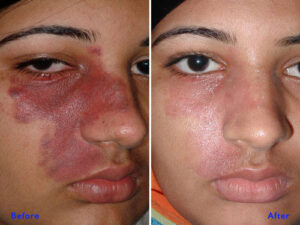From the times of early childhood, birthmarks have always been interesting to parents and the medical fraternity. But what causes them?
Is the cause of mental illness genes or the environment something else?
In this blog, we will talk about birthmarks, the theories, and a rather fascinating explanation as to why they are with us from the moment of birth. We at RamaCare, we offer state of the art BirthMark Removal Services across UAE.
Different Causes A Birthmark?
-
Genetic Factors
Concerning birthmarks, it is evident that they are a result of genetic factors. Some of the birthmarks like hemangiomas and port-wine stains are hereditary and therefore these children may be born with the same marks.
These changes can cause the formation of improper blood vessels or the improper grouping of pigment cells in some areas of the skin hence they result in visible birthmarks. Experts have established the link between certain genetic markers and the said skin irregularities, but the detailed interpretations of the processes involved are still rather detailed.
-
Development Causes
Birthmarks may also be caused by development as a result of incidents during pregnancy. For instance, dermal malformations including strawberry hemangiomas result from improper formation of blood vessels that take place before birth. Inherited pigmented lesions–moles or café-au-lait spots–come from the congregation of pigment cells within the skin.
These developmental abnormalities may be a result of minor characteristics of disorders in cell division and differentiation phases at the initial stage of fetal development. These causes explain that birthmarks can be a result of differences in the developmental processes of the human skin.
-
Environmental Causes
Still, birthmarks can also be the result of environmental factors, though they are a little more rare. Pregnant women exposed to items like radiation or certain chemicals may put the life of their unborn child in danger and cause conditions like birthmarks.
In the same respect, tissues that are pulled or receive blows during fetal development could be the cause of the birthmarks. Even though such environmental effects were not reported as frequently or in as much detail as genetic and developmental ones, the above overview illustrates that the development of birthmarks could be caused by several factors and influences.
Myths vs. Facts
Myth 1: Birthmarks are a result of the Mother’s Cravings
Of all the myths surrounding birthmarks, probably the most frequently heard is the myth that a birthmark is the result of some urge or craving that the mother had during pregnancy that was not satisfied.
For example, the desire for strawberries would possibly result in the formation of a strawberry mark on the baby’s skin. This is again a myth that has no scientific evidence behind it rather it is a myth that runs in people’s heads. Thus, birthmarks are biogenetic, and they are not connected to the diet or the emotions of the mother.
Fact 1: Birthmarks Can Be Hereditary
Research also reveals that some congenital skin outlets can be hereditary and may be passed through generations of a family. It is evident if the parent has a specific kind of birthmark, then the child has a probability of having the same birthmark. This genetic relation creates a solid foundation for the comprehension of why birthmarks may reoccur in generations in sequence.
Myth 2: Birthmarks Disappear on Their Own
A misconception is that all birthmarks are always naturally removable. The different birthmarks vary in nature while certain birthmarks specific to infants like the infantile hemangioma may disappear with time, then there are the port-wine stains or some pigmented birthmarks among others that may last to adulthood. However, it must be pointed out that the behavior of birthmarks may be different due to the type and causes of the birthmark.
Fact 2: Some Birthmarks Require Medical Attention
It has also been established that not all birthmarks have the same characteristics of benign tissue. Some, such as large congenital melanocytic nevi, even have a propensity of transforming into skin cancer sometime in the future.
Other congenital nevi, for instance, port wine nevi, might also demand treatment if they are large or have other health-related problems. One must seek the help of a healthcare provider to receive a correct diagnosis and subsequent treatment and management plan.
Conclusion
In conclusion, analyzing the causes and menacing myths about birthmarks lets us develop a clearer perspective on such skin disorders. Genetic, developmental, and epidemiological factors are involved in the development of birthmarks; therefore, myths should be differentiated from facts to give a proper approach to birthmarks and their treatment.
